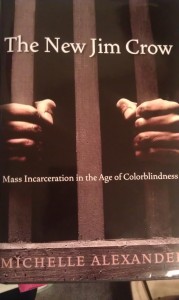I’m at the 2013 AWP Conference in Boston this week, and yesterday, I attended a session about teaching creative writing in the prison system–juvenile detention centers included. The main takeaway from the panel: a creative outlet allows people to stay in touch with their humanity even in the most seemingly hopeless of conditions.
Their stories of the value of creativity, education and self-expression elated me, but there was an elephant in the room. All the panelists were white, as was about 97% of the audience. Someone was bold enough to ask about prison population demographics and how the panelists’ cultural backgrounds had helped or challenged them in their work. They pretty much answered the latter question in terms of coming from the culture of teaching in an MFA program. One panelist had been incarcerated herself (and found common ground with the girls she mentors via her many tattoos) and another had been a drug addict. After the panel, I asked the moderator, who had noted that several of his original panelists had to drop out at the last minute, if any of his original panelists were not white. He said there was one Asian who couldn’t make it.
I find this problematic. I don’t think white people and Asians are the only ones willing to teach writing in the prison system. I think the demographics reflect who is in MFA programs, which also reflects who gets accepted into them, which is also about who’s teaching at these schools and is on the various selection committees, which is also about whites understanding of and acceptance of non-white people and their work and about minorities getting jobs in the as yet pro white male world of academia. (Seriously. There were sessions on all of these topics at some point yesterday, so I’m not making these issues up.) And without those teaching credentials, it may be hard to convince the directors of a prison, state or private, that you can handle teaching there.
But it’s not all about who holds the MFA. I do know of black artists who are uncomfortable teaching art in the prison system because it’s hard to deal with seeing people they know. I don’t work in prisons; I attended the panel because I could see myself doing some type of workshop with this population in the future, and I do think it could be painful, seeing people who look like me, knowing much of their predicament is just as much systemic injustice as it is poor choices, and knowing many will never have their lives back fully, even when they’re free.
Due to time, I wasn’t able to ask the panelists if their work behind bars has inspired a deeper sense of injustice and pushed them to action on the outside, or if they make those connections. I didn’t ask the man who has seen juvenile “offenders” locked up for smoking cigarettes if he realizes that’s not fair, or the woman who sees mostly black and Latina girls if she wonders why that is. This potential for cognitive dissonance concerns me when I see all white panelists on topics like teaching writing in prison, but I remain happy—for the inmates’ sake and for the arts’—that they do the work they do.


Good point! The only person I’ve only known two black poets who gained chances to share their work in New York prisons. They were not MFAers, but their access was brokered and controlled by whites. One of the poets who spoke at more than a half-dozen jails used to tell me that the prisoners are especially excited to hear and learn from artists from their race.
Drveevee,
Thanks for stopping by the blog and for commenting! It’s hard enough to get access if you have academic credentials, but when you don’t, someone with them probably holds the reins.